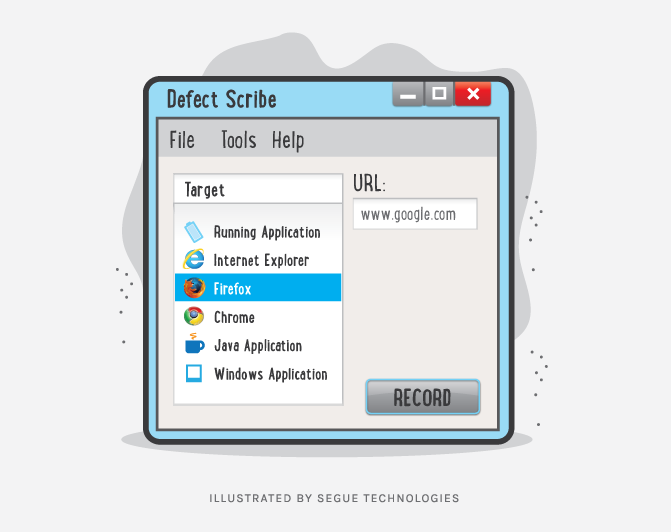It is virtually impossible to write test cases that cover every scenario that can occur. To uncover hidden risks, you need to go off script, and that is where using exploratory testing can help. Defect Scribe is a tool that makes exploratory testing less costly and time-consuming. Defect Scribe has been utilized by the Quality Control team at Segue to improve testing accuracy and efficiency when performing exploratory testing.
What is Exploratory Testing?
In software testing, exploratory testing is pretty much what it sounds like. It is a testing method in which testers “explore” an application to determine what it does and does not do and how it works. Exploratory testing allows testers to learn the functionality of the application. From this basis of understanding, testers are able to develop testing scenarios, design test cases, and find bugs.
Exploratory testing is most often employed in situations where the application is very early in the software development life cycle (SDLC), or the quality assurance processes are severely restricted in some way, usually by time or poor specifications. For example, a new client wants their legacy application redone, but they have no documented requirements from their original development team. In this scenario, testers could employ exploratory testing to learn how the legacy system currently functions, and simultaneously gather information for user and test case formation.
This type of testing gives testers a great deal of freedom, but depends heavily on their experience and skill. Instead of following a predetermined script, an exploratory tester is required to simultaneously design and execute a test, observe test results, and use what they have just experienced to design the next test. But what good is all this testing if it is not documented? Here comes the major disadvantage of exploratory testing: remembering the exact testing scenario that produced the results. Documenting the exact steps to reproduce a result can be tedious, time consuming, and fraught with error. Save button or submit button? This is where having a tool like Defect Scribe available comes in handy.
What is Defect Scribe?
Defect Scribe is a product in Seapine’s suite testing products that has been utilized by the Quality Control team at Segue to improve testing accuracy and efficiency. Defect Scribe is an automated screen capture tool compatible with Microsoft Windows, Java, Qt, Flash, and browser- based (Chrome, Firefox, and Internet Explorer) applications that enable testers to perform exploratory testing without having to stress over documenting their every action.
With Defect Scribe, a tester can create a detailed record of the testing session that will include descriptions and screen shots of the interface controls used. If you click the“Record” button in Defect Scribe it will convert all of the tester’s actions into a step-by-step script that can then be edited to change steps and add additional notes or comments. The scripts can then be saved as a test case in TestTrack TCM or defect ticket in TestTrack Pro. It is also possible to integrate Defect Scribe API to create a plug-in to create defects if you are using another third-party issue tracking tool suite. Defect Scribe handles the bulk of documenting the testing session, which frees up more time for the tester to explore the application. It generates detailed steps-to-reproduce, which makes it a breeze for testers to create test cases, report defects, communicate defects effectively to developers, and even serve as a basis for user documentation.
Defect Scribe is a free add-on for TestTrack TCM users and available to purchase separately from Seapine’s Software Testing Tools site. For more information on Defect Scribe and Seapine’s other software lifecycle management products, go to their website.
When clients balk at shrink testing budgets in proposals, some companies settle for an incomplete test plan because it will lower cost estimates while still satisfying minimal quality standards. However, all that really accomplishes is increasing the possibility of a buggy release. Combining exploratory testing and scripted testing can help fill the gap left by shrinking resources to keep your test effort strong and reduce the risk of defects in the release. The Quality Control team at Segue has found that using Defect Scribe helps to meet quality standards, while still remaining cost effective.
